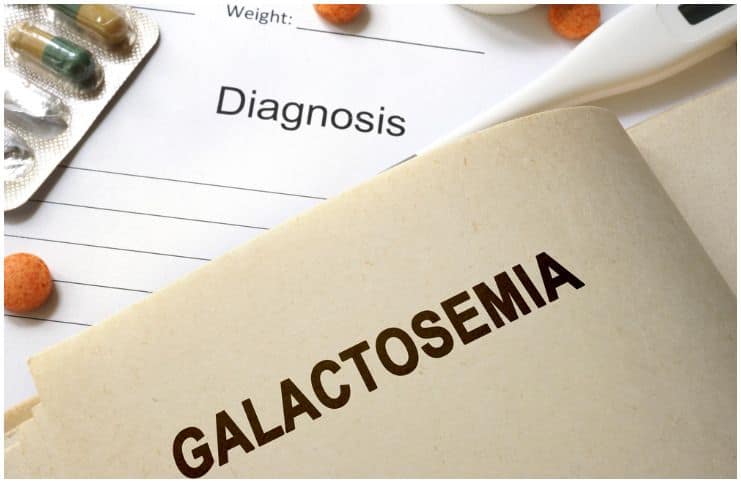Facts About Galactosemia:
Galactosemia is an inherited disease that reduces the body’s capacity to metabolize galactose, which belongs to simple carbohydrates. Because this simple sugar cannot be broken down properly, it builds up in the blood.
The prominent symptoms include:
- vomiting;
- poor feeding;
- jaundice;
- ascites (abnormal buildup of fluid in the abdomen);
- hepatomegaly;
- hypoglycemia.
Here Is A List Of 22 Interesting Facts About Galactosemia:
Statistics
1 Worldwide, the estimated prevalence is between 1 in 30,000 to 60,000 live births. The estimated incidence in the US is 1 in 53,000. The incidence in the United Kingdom is around 1:45 000 live births.
2 Females and males are equally affected. The disorder appears to be more common in the Caucasian population. Clinical variant galactosemia occurs most frequently in native Africans in South Africa and African Americans who have a specific GALT gene mutation.
3 The disorder is thought to be much less common among Asian people. The Duarte variant occurs in about 1 in 16,000 live births.
Types
4 There are four types of galactosemia:
- Galactose-1 phosphate uridyl transferase deficiency – in this type, the mutation occurs in the GALT gene. It is the most common type, with the most severe symptoms;
- Deficiency of galactose kinase – it is caused by mutations in the GALK1 gene;
- The deficiency of galactose-6-phosphate epimerase – it is caused by mutations in the GALE gene;
- Duarte variant galactosemia – in this type, the affected individual has mutations in the GALT gene, however, he has a partial deficiency of the enzyme by around 75 percent. Sufferers of this type commonly may or may not need treatment, and they do not have serious health effects. Some patients may develop jaundice, however, this symptom usually resolves when he or she is switched to a low-galactose diet.
Symptoms
5 Common symptoms include the following:
- bleeding or excessive bruising;
- poor weight gain;
- poor feeding;
- full fontanelle (the space between the bones of an infant’s skull where the sutures intersect);
- diarrhea;
- encephalopathy (a term that means brain damage, disease, or malfunction);
- vomiting;
- yellow eyes;
- cataracts;
- yellow skin;
- lethargy and hypotonia;
- pale or clay-colored stools;
- yellow discoloration of urine;
- hepatomegaly.
6 Note – for a newborn with classic galactosemia, the above symptoms may start within several days of starting to drink a cow’s milk-based baby formula or breastfeeding.
When to Call the Doctor
7 Parents should notify their healthcare professional if their child displays any of the signs or symptoms of galactosemia.
Complications
8 Long-term complications include:
- mental retardation;
- decreases in bone mineral density;
- premature ovarian failure (the loss of normal function of your ovaries before age 40);
- cataracts – according to the data, an estimated 10 to 30 percent of newborns with classic galactosemia develop cataracts in the first few days of life.
Causes
9 Mutations in the GALT, GALK1, and GALE genes cause galactosemia. The gene mutation that occurs is inherited in what is known as an autosomal recessive pattern. This means that 2 copies of the defective gene have to be inherited for galactosemia to appear.
If two carriers conceive a baby, that baby has:
- a 1 in 4 chance of being born with the disease;
- a 1 in 2 chance of having a child who is a carrier for the disease;
- a 1 in 4 chance of having a child without any of the genes for the disease.
Risk Factors
10 People with a family history of galactosemia are at great risk of inheriting the disease.
Diagnosis
11 The diagnosis of the disease is established by the detection of:
- biallelic pathogenic variants in GAL;
- reduced erythrocyte galactose-1-phosphate uridylyltransferase enzyme activity;
- elevated erythrocyte galactose-1-phosphate concentration.
12 A galactose tolerance test should never be done since it may be harmful to the infant.
13 All 50 states in the United States test newborns for the disease.
Treatment
14 In order to avoid the consequences of the disease, which may include cataracts and/or brain damage, kidney dysfunction, and liver failure, babies must be treated promptly by removing lactose from the diet.
15 The following foods must be avoided:
- milk and all dairy products;
- any foods or drugs that contain the ingredients casein (one of the major proteins in milk), lactulose, lactalbumin, caseinate (the soluble salts of acid casein), whey, curds, or whey solids;
- some vegetables and fruits also contain galactose;
- some candies;
- tomato sauces;
- pre-packaged foods may contain lactose;
- certain medications, such as – capsules, tablets, and sweetened liquid drops that contain lactose as a filler.
16 Soy-based formulas are given as an alternative unless there is a liver disease. This diet should be continued for life.
17 If your baby doesn’t tolerate a soy-based formula, an elemental formula, like – Alimentum (contains a predigested protein that is broken down into small pieces) or Nutramigen may be used instead. However, these elemental formulas do have some galactose.
18 The dietary treatment is usually insufficient in preventing long-term complications, like -social, cognitive, and reproductive impairments.
19 The disease can affect puberty, therefore, hormone replacement therapy may be required. In addition, hormone replacement therapy and genetic counseling may be suggested.
20 According to studies, the restriction of galactose intake by the mother during pregnancy may not improve the outcome in siblings with the disease.
Prognosis
21 Most individuals who are diagnosed early with the disease and carefully follow a galactose-free diet, appear to reach adulthood. If untreated, classic galactosemia is a life-threatening disease. Boys usually have a normal testicular function, whereas girls usually have ovaries that do not function properly.
Prevention
22 The disease is not preventable.
READ THIS NEXT:
Interesting Facts About Eubacteria
Interesting Facts About Salmonella Bacteria
Famous People With Prosopagnosia
References http://genetics.emory.edu/research/fridovich-keil/galactosemia.html https://link.springer.com/article/10.1007/s10545-017-0029-3 https://jamanetwork.com/journals/jama/article-abstract/332227
